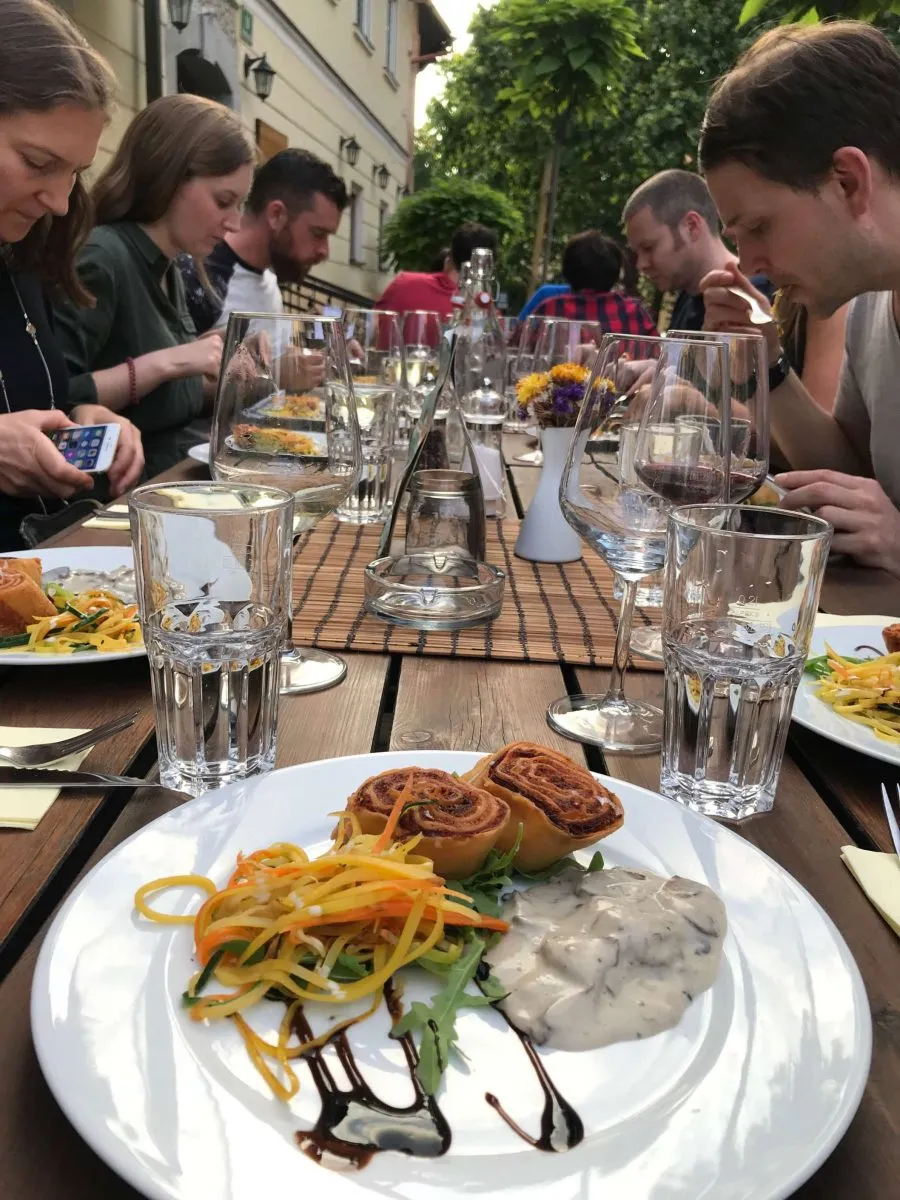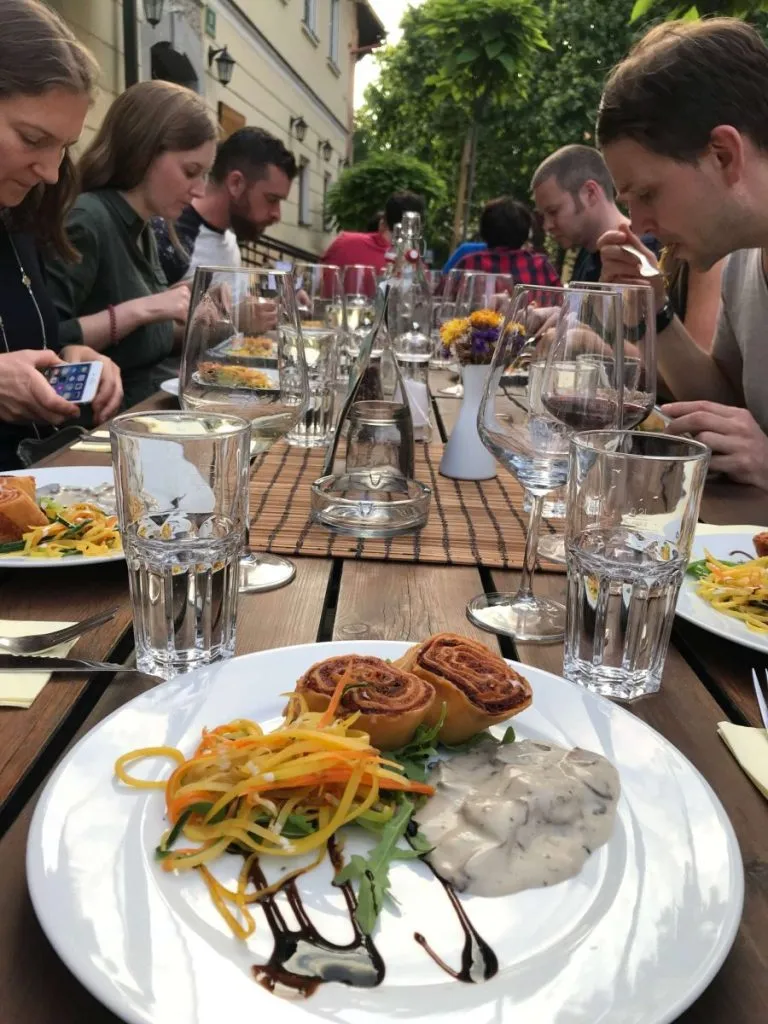Slovenia is a paradise for food lovers, with a rich and diverse cuisine from 24 gastronomic regions.
If you were to go on a culinary journey around Slovenia, you’ll soon notice the gastronomic influences from its neighbouring countries: Italy, Austria, Hungary, and Croatia. Pasta dishes, gnocchi, and risottos from Italy; sausage, schnitzel, and strudel from Austria; goulash and stuffed paprikas from Hungary; seafood and other Mediterranean dishes from Croatia. We’re just skimming the surface here.
With its rich food offer, Slovenia enables you to taste various dishes that are typical of as many as 24 culinary regions. Some dishes can be eaten at restaurants across the country while others are exclusively reserved for their place of origin. You can also very conveniently discover a variety of Slovene foods right in Ljubljana and Bled.
Here are some of the most popular and symbolic Slovenian foods.
Top Slovenian Foods & Dishes (including desserts)
Kranjska klobasa (Carniolian Sausage)
Carniolan sausage is the best known Slovenian food in the world, apart from ‘potica’ and ‘štruklji’. Well, not only has it been around since 1896, the European Commission gave it the Protected Geographical Indication (PGI) seal in 2015, and it’s also the first sausage to have entered space! Kranjska sausage gets its name from the region of Carniola, a former duchy of the Austria Empire, where it originated. It is smoked and must be prepared using exact portions of pork (68%), beef (12%), and bacon (20%). It’s usually boiled, grilled, or fried, and served with a variety of accompaniments, including sour cabbage, potatoes and mustard.
Kraški pršut (Karst Prociutto)
‘Kraški pršut’ (Karst cured ham or prosciutto) is another very famous Slovenian food. It is typical of the Karst region in Slovenia and is also a product of Protected Geographical Indication. There’s a centuries-old tradition to it, of salting and drying meat with the help of the strong bora wind, locally called ‘burja’. It is prized for its excellent flavour and texture, and goes perfectly well with Teran, the region’s equally prized red wine.
Štruklji (Curd Cheese Dumplings)
‘Štruklji’ are another traditional Slovenian food that’s known all over Slovenia and even among international food enthusiasts. They’re made from different kinds of dough, with a diverse range of fillings, baked or boiled, sweet or savoury. The best known variations are with curd cheese, tarragon, walnut, or poppy seed fillings.
Idrijski žlikrofi (Idrija Dumplings)
These traditional Slovenian dumplings from the town of Idrija are a ravioli-type dish with potato filling. You’ll easily recognise them via their distinctive shape. The recipe dates back to the mid-19th century, yet they remain one of the most popular Slovenian dishes. They also gained protected geographical status in 2010.
Jota (Yota)
Stews might be found in quite a few countries, but the Slovenes consider their ‘Jota‘ to be something truly special as it varies according to region and season. This thick, hearty soup is prepared using turnip, beans, onions, and sometimes smoked pork ribs. And speaking of regional variations, in Istria (southwest Slovenia) the stew contains sour cabbage (‘kislo zelje’) rather than turnip, and doesn’t include potatoes. In other areas, other local vegetables and sometimes barley are added.
Žganci (Mush)
‘Žganci’ are one of the simplest and most popular Slovenian foods, that also varies according to region. Potato ‘žganci’ are typical of Prekmurje and Pohorje in the northeast of Slovenia, while buckwheat ‘žganci’—made from buckwheat flour, water, salt, and oil—are common in Gorenjska (northwest Slovenia). They often come topped with pork crackling (‘ocvirki’), which add a nice meaty touch to this meal.
Pražen krompir (Sautéed Potatoes with Onion)
‘Tenstan’ or ‘pražen krompir’ are the most popular version of a potato dish in Slovenia. Potatoes are boiled and then fried together with onions, making them the perfect side dish for most meat specialties. Here again, you might even find the addition of pork crackling. Pražen krompir became such a hit in Slovenia that a society was formed in Ljubljana in 2002 to promote and safeguard their reputation.
Potica (Potizza or Nut Roll)
‘Potica‘ is the most symbolic dessert of Slovenia. It’s made of dough to form a roulade-like or roly-poly shape. There are around 80 known types of fillings, but the most popular are tarragon (‘pehtran’), walnuts, cracknels (‘ocvirki’), and poppy seeds. Potica is mostly popular during festive seasons such as Christmas and Easter time.
Prekmurska gibanica (Prekmurje Layered Cake)
This dessert from Prekmurje gained its fame due to its multi-layered composition, not to mention its amusing name which translates to ‘Moving cake from Prekmurje’. Prekmurska Gibanica is also protected so it can only be made according to certain standards with ingredients of specific quantities. So a certain amount of poppy seeds, curd cheese, walnuts and apples.
Kremna rezina or Blejska kremšnita (Bled Cream Cake)
Bled Cream Cake is the dessert that Bled or Lake Bled is famous for. In other words, you won’t leave Bled without seeing or hearing about what the locals refer to as kremna rezina or more colloquially as kremšnita, a cube-shaped vanilla custard and chantilly centre sandwiched between two layers of puff pastry and a sugar dusting on top.
Jabolčni štrudelj (Apple Strudel)
Apple strudel is a dessert that you’ll come across more often in Slovenia’s Alpine regions, as it originates from Austria. It’s a flaky puff pastry dusted with an icing sugar coating filled with a juicy apple filling that usually contains cinnamon. The recipe varies from house to house, so you’ll never find two versions that are exactly the same.
Where to Taste Traditional Slovenian Food
Are you hungry for some heartwarming, traditional Slovenian food? We’re pretty sure you are. How about trying them out at one of Slovenia’s traditional restaurants. Or you could go on a food walk or food tour of Ljubljana and Bled, during which you’ll get some cool details about Slovene cuisine from your guide. And don’t forget! Slovenia is also well known for its wines, so if you would like to get a genuine experience with local food and wine, check out Wine Tours Slovenia.
You may also enjoy a variety of foods by visiting the many food-themed events that take place around the country throughout the year. We wish you bon appétit, or ‘dober tek’ as we say in Slovenia!












